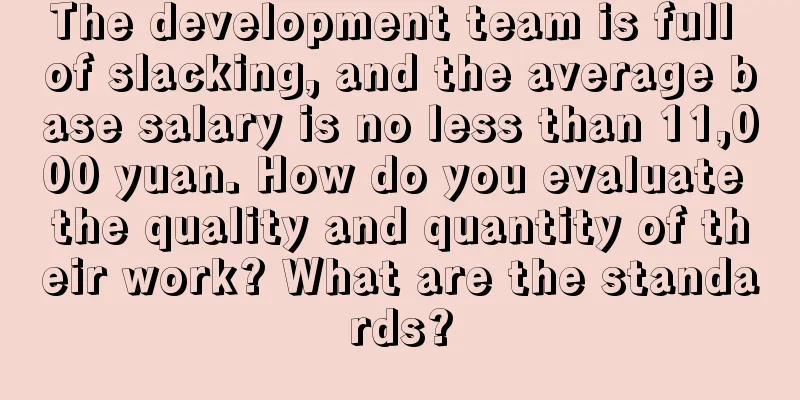The development team is full of slacking, and the average base salary is no less than 11,000 yuan. How do you evaluate the quality and quantity of their work? What are the standards?

"Wonderful Reply" Lost Uncle -Drunk in the Sutra Pavilion with half a scroll of books, sitting in the well and talking about the vastness of the sky Thank you for the invitation. I understand that the main questions of the poster are two: 1. How to solve the problem of developing employees’ work enthusiasm; 2. Specific indicators to quantify workload and quality, and indicators to quantify salary and ability. (1) Whether the intention (or motivation) is strong; (2) Whether the abilities and skills are sufficient or can be achieved with a little effort; (3) Trigger mechanism. The poster mentioned above that he was not very motivated and often slacked off. At first glance, this seems to be a problem of willingness, but it does not rule out problems with insufficient skills and trigger mechanisms. From the perspective of willingness alone, there are probably three aspects: whether it is tempting to achieve the goal, whether there are obstacles in the process, and whether there are relatively large risks. You need to analyze your current actual situation one by one. Regarding temptation, in addition to actual benefits, I think what needs to be emphasized more is the improvement of capabilities, because only when the capabilities are improved can we achieve greater success and have more actual benefits. This must be made clear to development colleagues. In addition, if conditions permit, you can create an atmosphere of daring to fight and strive. People are the product of their environment and are influenced by it. You can also create an atmosphere by setting benchmarks. If the poster does not want to make it so complicated, I personally think he should do two things well. First, recruit people who have a strong desire to get things done. Second, pay attention to guiding the company's atmosphere (you can find relevant books on how to lead a team and manage to learn). It is very necessary to quantify as much as possible, so that we can evaluate a person's value, which is actually good for everyone. In this way, good talents can be identified, and more work, more pay, less work, less pay, and no work, no pay. I personally suggest that we should be result-oriented and guide the company based on the results it cares about. For example, if the company cares about profit, product success rate, payment period, experience sharing, etc., then you can set corresponding indicators and different weights for assessment. In the small company stage, it is not recommended to set too complicated. I personally think that profit and success rate are important. If it is set too complicated, it will be troublesome to assess, and people are also disgusted by such complicated things. I will not disclose the specific indicators. Please forgive me. At the same time, I also hope that the poster will set detailed quantitative items and assessment cycles according to the actual situation of the company and his own expectations. I had experience in this area in a Fortune 500 company. At that time, I needed to develop skill level classification standards, expert appointments, certification processes, and organize defense for skill certification. If the poster insists on doing this, first consider performance support, which is the most important part and has the highest weight; secondly, consider what professional knowledge is needed for the categories you are involved in, what knowledge and skill levels different levels should have, and the results of written tests and defense. In the end, you need to combine the two aspects to judge the skill level, and you can even include work attitude as a standard. For example, Alibaba has relevant annotation content. Anonymous user I think you need to first analyze the possible reasons for your low enthusiasm for development and frequent slacking off. Because development and operations are different, operations are after sales, and poor data, poor products, low market fit, etc. lead to poor performance, but product development is more about personal development and analysis awareness and the matching of company positioning. Of course, if it is an employee’s problem, it will be discussed separately, but if the whole team is like this, either there is a problem with the system design, or the screening work was not done well during the recruitment/probation period. That is, first identify the problems or potential problems that may cause development to fail, and then think about how to solve them.
When recruiting, we develop salaries based on product lines and category experience. For example, if we are planning to develop lighting products this year, we are willing to pay higher salaries to developers with lighting-related experience and good overall quality, because if the level of development is good and the job is well matched, we are willing to pay them 20-30% higher than the original salary.
Anonymous user I think to increase enthusiasm, the commission of subsequent orders should be taken into account, with the arrival of the first batch of products at the Amazon warehouse as the starting date. In the first year, you can get x% of the net profit commission, and in the next year, you can get x/2%. After 2 years, you will not enjoy any commission, or you can set a fixed amount of 0.3-1%. If you want to encourage the development of explosive products, you can set it up in a step-by-step manner: 50w USD X% Another thing to consider is the performance of development. The promotion of operations will have a great impact on it. To solve this problem, developers can first filter out several important data for operation reference, and operations can also check whether the data given is correct. |
Recommend
What is Squarespace? Squarespace Review
Squarespace is an online tool that is used to buil...
What is India's ARAI vehicle and parts certification? India's ARAI vehicle and parts certification review
The Automotive Research Association of India (ARAI...
What is IPEGA? IPEGA Review
Ipega was founded in 1994. It is a large-scale nat...
Insights into the brand preferences of Generation Z in the United States! Amazon and Walmart remain popular
According to a new survey by Morning Consult, Amaz...
Starting from scratch, Shopify's 30-day store opening tutorial - Day 23
Hello again! Do you remember what we learned in y...
New features are launched. Is Amazon going to help you make money?
Amazon is now blocking various borderline operati...
What is BPOM certification? BPOM certification evaluation
BPOM is the abbreviation of the Indonesian Food an...
New trends in cross-border platform investment in 2025: US market becomes the focus
As 2024 draws to a close, many cross-border e-com...
She graduated from junior high school, had 5,000 stores closed, and went from being in debt to earning 30 million a year. What did she rely on?
Hello everyone, I am TK Xiaobaiquan-Pear . Many pe...
What is Innojoy Patent Search Engine? Innojoy Patent Search Engine Review
Innojoy Patent Database is a patent intelligence c...
What is Olsam? Olsam Review
Olsam is a technology-driven consumer products com...
What is CashCowPro? CashCowPro Review
CashCowPro is a comprehensive Amazon management to...
12315 report to follow-selling is successful! The Market Supervision Bureau has listed the address of the follow-selling company as abnormal operation!
Amazon Anonymous user Presumably, everyone hates f...
What is Eyewa? Eyewa Review
Eyewa is a vertical e-commerce company specializin...
What is JC Penney? JC Penney Review
JC Penney is an American department store chain wi...









